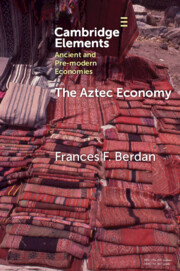57 results

The Aztec Economy
-
- Published online:
- 25 April 2023
- Print publication:
- 18 May 2023
-
- Element
- Export citation
4 - The Merchant
- from Part I - Lives
-
- Book:
- Everyday Life in the Aztec World
- Published online:
- 13 November 2020
- Print publication:
- 03 December 2020, pp 83-105
-
- Chapter
- Export citation
Glossary
-
- Book:
- Everyday Life in the Aztec World
- Published online:
- 13 November 2020
- Print publication:
- 03 December 2020, pp 237-238
-
- Chapter
- Export citation
A Little Background
-
- Book:
- Everyday Life in the Aztec World
- Published online:
- 13 November 2020
- Print publication:
- 03 December 2020, pp xv-xxiii
-
- Chapter
- Export citation
Copyright page
-
- Book:
- Everyday Life in the Aztec World
- Published online:
- 13 November 2020
- Print publication:
- 03 December 2020, pp iv-iv
-
- Chapter
- Export citation
8 - Market Day in Tlatelolco
- from Part II - Intersecting Lives
-
- Book:
- Everyday Life in the Aztec World
- Published online:
- 13 November 2020
- Print publication:
- 03 December 2020, pp 170-191
-
- Chapter
- Export citation
7 - A Child Is Born
- from Part II - Intersecting Lives
-
- Book:
- Everyday Life in the Aztec World
- Published online:
- 13 November 2020
- Print publication:
- 03 December 2020, pp 147-169
-
- Chapter
-
- You have access
- HTML
- Export citation
Contents
-
- Book:
- Everyday Life in the Aztec World
- Published online:
- 13 November 2020
- Print publication:
- 03 December 2020, pp v-vi
-
- Chapter
- Export citation
10 - A Battle Far Afield
- from Part II - Intersecting Lives
-
- Book:
- Everyday Life in the Aztec World
- Published online:
- 13 November 2020
- Print publication:
- 03 December 2020, pp 208-231
-
- Chapter
- Export citation
3 - The Featherworker
- from Part I - Lives
-
- Book:
- Everyday Life in the Aztec World
- Published online:
- 13 November 2020
- Print publication:
- 03 December 2020, pp 54-82
-
- Chapter
- Export citation
Pronunciation Guide
-
- Book:
- Everyday Life in the Aztec World
- Published online:
- 13 November 2020
- Print publication:
- 03 December 2020, pp xiii-xiv
-
- Chapter
- Export citation
5 - The Farmer
- from Part I - Lives
-
- Book:
- Everyday Life in the Aztec World
- Published online:
- 13 November 2020
- Print publication:
- 03 December 2020, pp 106-125
-
- Chapter
- Export citation
Part II - Intersecting Lives
-
- Book:
- Everyday Life in the Aztec World
- Published online:
- 13 November 2020
- Print publication:
- 03 December 2020, pp 145-236
-
- Chapter
- Export citation
A Note on Sources
-
- Book:
- Everyday Life in the Aztec World
- Published online:
- 13 November 2020
- Print publication:
- 03 December 2020, pp xxiv-xxviii
-
- Chapter
- Export citation
Part I - Lives
-
- Book:
- Everyday Life in the Aztec World
- Published online:
- 13 November 2020
- Print publication:
- 03 December 2020, pp 1-144
-
- Chapter
- Export citation
6 - The Slave
- from Part I - Lives
-
- Book:
- Everyday Life in the Aztec World
- Published online:
- 13 November 2020
- Print publication:
- 03 December 2020, pp 126-144
-
- Chapter
- Export citation
Index
-
- Book:
- Everyday Life in the Aztec World
- Published online:
- 13 November 2020
- Print publication:
- 03 December 2020, pp 247-260
-
- Chapter
- Export citation
List of Fictional Characters
-
- Book:
- Everyday Life in the Aztec World
- Published online:
- 13 November 2020
- Print publication:
- 03 December 2020, pp xxix-xxx
-
- Chapter
- Export citation
2 - The Priest
- from Part I - Lives
-
- Book:
- Everyday Life in the Aztec World
- Published online:
- 13 November 2020
- Print publication:
- 03 December 2020, pp 34-53
-
- Chapter
- Export citation
References
-
- Book:
- Everyday Life in the Aztec World
- Published online:
- 13 November 2020
- Print publication:
- 03 December 2020, pp 239-246
-
- Chapter
- Export citation

